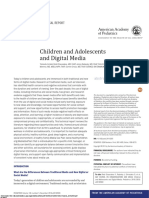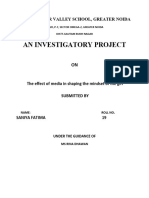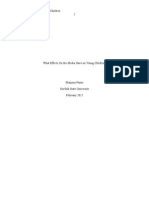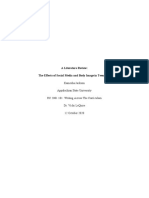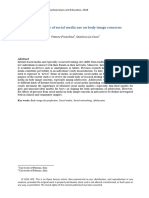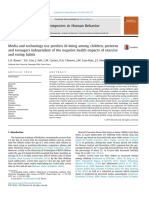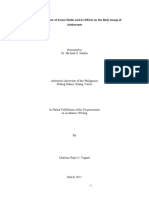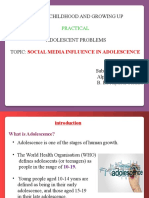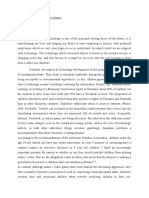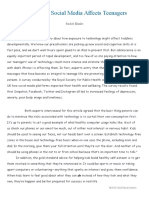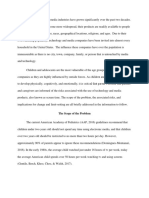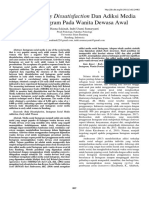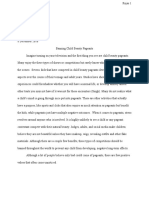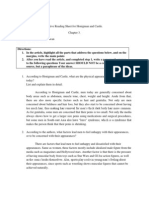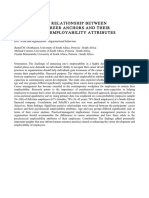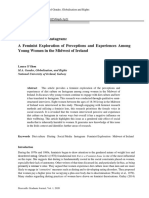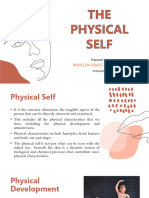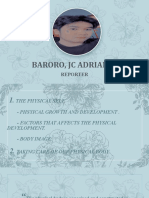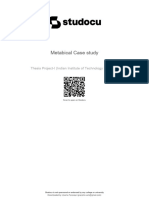Bibliography
1. Al‐Saggaf, Y. and O’Donnell, S.B. (2019). Phubbing: Perceptions, reasons behind,
predictors, and impacts. Human Behavior and Emerging Technologies, [online] 1(2),
pp.132–140. Available at:
https://www.researchgate.net/publication/332337844_Phubbing_Perceptions_reasons
_behind_predictors_and_impacts [Accessed 28 May 2019].
2. American Academy of Pediatrics (2013). Parental Controls & Digital Monitoring.
[online] www.aap.org. Available at: https://www.aap.org/en/patient-care/media-and-
children/center-of-excellence-on-social-media-and-youth-mental-health/qa-portal/qa-
portal-library/qa-portal-library-questions/parental-controls--digital-monitoring/.
3. American Academy of Pediatrics. (2016). The Impact of Social Media on
Children, Adolescents, and Families. Pediatrics, 138(5), e20162592.
4. Andreassen, C. S., Kross, E., Woods, D. S. & Scott, S., 2016. Social media
and mental health: Benefits, risks, and opportunities. National Library of
Medicine. Available at:
https://pmc.ncbi.nlm.nih.gov/articles/PMC7785056/#ABS1 [Accessed 4
January 2025].
5. Ballara, N.B. (2023). The Power of Social Validation: A Literature Review on
How Likes, Comments, and Shares Shape User Behavior on Social Media.
International Journal of Research Publication and Reviews, [online] 4(7),
pp.3355–3367. doi:https://doi.org/10.55248/gengpi.4.723.51227.
6. Ballara, N.B. (2023). The Power of Social Validation: A Literature Review on How
Likes, Comments, and Shares Shape User Behavior on Social Media. International
Journal of Research Publication and Reviews, [online] 4(7), pp.3355–3367. Available
at: https://ijrpr.com/uploads/V4ISSUE7/IJRPR15703.pdf.
7. Burnette CB, Kwitowski MA, Mazzeo SE. “I don’t need people to tell me I’m
pretty on social media:” a qualitative study of social media and body
image in early adolescent girls. Body Image. 2017;23:114–25.Return to ref
11 in article
1
�8. Burnette, C.B., Kwitowski, M.A. and Mazzeo, S.E., 2017. “I don’t need
people to tell me I’m pretty on social media:” a qualitative study of social
media and body image in early adolescent girls. Body Image, 23, pp.114–
125. Available at: https://doi.org/10.1016/j.bodyim.2017.08.004 [Accessed
5 January 2025].
9. Christakis, D.A., Ramirez, J.S.B., Ferguson, S.M., Ravinder, S. and Ramirez, J.-M.
(2018b). How early media exposure may affect cognitive function: A review of res-
ults from observations in humans and experiments in mice. Proceedings of the Na-
tional Academy of Sciences of the United States of America, [online] 115(40),
pp.9851–9858. doi:https://doi.org/10.1073/pnas.1711548115
https://pubmed.ncbi.nlm.nih.gov/30275319/.
10.Christakis, D.A., Ramirez, J.S.B., Ferguson, S.M., Ravinder, S., and Ramirez,
J.-M., 2018. How early media exposure may affect cognitive function: A
review of results from observations in humans and experiments in mice.
Proceedings of the National Academy of Sciences, 115(40), pp.9851–9858.
Available at: https://pubmed.ncbi.nlm.nih.gov/30275319/ [Accessed 4
January 2025].
11. Cookingham, L.M. and Ryan, G.L. (2015). The Impact of Social Media on the Sexual
and Social Wellness of Adolescents. Journal of Pediatric and Adolescent Gynecology,
[online] 28(1), pp.2–5. Available at:
https://www.sciencedirect.com/science/article/abs/pii/S1083318814001636
12.Coolest Gadgets. (2023). Smartphone Statistics: How Many People Use
Smartphones in 2023? [online] Available at: https://www.coolest-
gadgets.com/smartphone-statistics/#:~:text=In%202023%2C%20around
%206.92%20billion%20people%2C%20or%2085.74%25,population%20will
%20own%20smartphones%2C%20totaling%207.33%20billion%20users
[Accessed 4 January 2025].
2
�13. Council on Communications and Media (2016a). Media Use in School-Aged Children
and Adolescents. Pediatrics, [online] 138(5), p.e20162592. Available at:
https://publications.aap.org/pediatrics/article/138/5/e20162592/60321/Media-Use-in-
School-Aged-Children-and-Adolescents.
14. Council on Communications and Media (2016b). Media Use in School-Aged Children
and Adolescents. Pediatrics, [online] 138(5), p.e20162592. Available at:
https://publications.aap.org/pediatrics/article/138/5/e20162592/60321/Media-Use-in-
School-Aged-Children-and-Adolescents.
15. Dallesasse, S.L. and Kluck, A.S. (2013a). Reality television and the muscular male
ideal. Body Image, [online] 10(3), pp.309–315. Available at:
https://www.sciencedirect.com/science/article/abs/pii/S1740144513000284?via
%3Dihub.
16. Dallesasse, S.L. and Kluck, A.S. (2013b). Reality television and the muscular male
ideal. Body Image, [online] 10(3), pp.309–315. Available at:
https://www.sciencedirect.com/science/article/abs/pii/S1740144513000284?via
%3Dihub.
17. Dallesasse, S.L. and Kluck, A.S. (2013c). Reality television and the muscular male
ideal. Body Image, [online] 10(3), pp.309–315. Available at:
https://www.sciencedirect.com/science/article/abs/pii/S1740144513000284?via
%3Dihub.
18.Equip Health. (n.d.). Body image and eating disorders. Equip Health.
Available at: https://equip.health/articles/body-image/body-image-and-
eating-disorders [Accessed 4 January 2025].
19.Equip Health. (n.d.). Body image and eating disorders. Equip Health.
Available at: https://equip.health/articles/body-image/body-image-and-
eating-disorders [Accessed 4 January 2025].
20. Erikson, E.H. (1968). Identity, youth and crisis. New York: W. W. Norton Company,
1968. Behavioral Science, [online] 14(2), pp.154–159.
doi:https://doi.org/10.1002/bs.3830140209.
21.Fardouly, J., Diedrichs, P. C., Vartanian, L. R., & Halliwell, E. (2015). Social
comparisons on social media: The impact of Facebook on young women's
3
� body image concerns and mood. Body Image, 13, 38-45.
https://doi.org/10.1016/j.bodyim.2014.12.004
22.Fardouly, J., Diedrichs, P. C., Vartanian, L. R., & Halliwell, E. (2015). Social
comparisons on social media: The impact of Facebook on young women's
body image concerns and mood. Body Image, 13, 38-45.
https://doi.org/10.1016/j.bodyim.2014.12.004
23. Fardouly, J., Pinkus, R.T. and Vartanian, L.R. (2017). The impact of appearance com-
parisons made through social media, traditional media, and in person in women’s
everyday lives. Body Image, [online] 20(1), pp.31–39. Available at:
https://www.sciencedirect.com/science/article/abs/pii/S1740144516303217.
24.Fardouly, J., Pinkus, R.T. and Vartanian, L.R., 2017. The impact of
appearance comparisons made through social media, traditional media,
and in person in women’s everyday lives. Body Image, 20, pp.31-39.
Available at:
https://www.sciencedirect.com/science/article/abs/pii/S1740144516303217
[Accessed 5 January 2025].
25.Fardouly, J., Pinkus, R.T. and Vartanian, L.R., 2017. The impact of
appearance comparisons made through social media, traditional media,
and in person in women’s everyday lives. Body Image, 20, pp.31-39.
Available at: https://doi.org/10.1016/j.bodyim.2017.02.001 [Accessed 5
January 2025].
26.Fuchs, C. (2017) Social media: A critical introduction. London: Sage
Publications
27.Fuchs, C. (2023). Social Media. [online] Sage Publications Ltd. Available at:
https://uk.sagepub.com/en-gb/eur/social-media/book273755#preview.
28. Fuchs, C. (2023). Social Media. [online] Sage Publications Ltd. Available at:
https://uk.sagepub.com/en-gb/eur/social-media/book273755#preview.
4
�29. Granic, I., Lobel, A. and Engels, R.C.M.E. (2014). The Benefits of Playing Video
Games. American Psychologist, [online] 69(1), pp.66–78.
doi:https://doi.org/10.1037/a0034857
https://www.apa.org/pubs/journals/releases/amp-a0034857.pdf.
30.Granic, I., Lobel, A., and Engels, R.C.M.E., 2014. The benefits of playing
video games. American Psychologist, 69(1), pp.66-78. Available at:
https://pubmed.ncbi.nlm.nih.gov/24295515/ [Accessed 4 January 2025].
31.J. Piaget, (1972). Intellectual Evolution from Adolescence to Adulthood,
Volume 51 (1), pages 40-47 available at
(https://www.jstor.org/stable/26763966)
32. John P. Kemph Erik H. Erikson identity, youth and crisis. W. W.
Norton Company, Volume 14 (2), pages 154-159. Available at
(https://onlinelibrary.wiley.com/doi/pdf/10.1002/bs.3830140209)
33.Kendra Cherry, 2022. What is Phubbing? Verywell Mind. Available at:
https://www.verywellmind.com/what-is-phubbing-8647390?
utm_source=chatgpt.com [Accessed 4 January 2025].
34.Khalaf, A.M. (2023). The Impact of Social Media on the Mental Health of
Adolescents and Young Adults: a Systematic Review. Cureus, [online]
15(8). doi:https://doi.org/10.7759/cureus.42990.
35. Khalaf, A.M. (2023). The Impact of Social Media on the Mental Health of Adoles-
cents and Young Adults: a Systematic Review. Cureus, [online] 15(8). Available at:
https://www.researchgate.net/publication/332337844_Phubbing_Perceptions_reasons
_behind_predictors_and_impacts.
36.Kross E, Verduyn P, Demiralp E, et al. Facebook use predicts declines in
subjective well-being in young adults. PLoS One 2013;8:e69841. [DOI]
[PMC free article] [PubMed] [Google Scholar]).
5
�37.Kross E, Verduyn P, Demiralp E, et al. Facebook use predicts declines in
subjective well-being in young adults. PLoS One 2013;8:e69841. [DOI]
[PMC free article] [PubMed] [Google Scholar]
38. Kross, E., Verduyn, P., Demiralp, E., Park, J., Lee, D.S., Lin, N., Shablack, H.,
Jonides, J. and Ybarra, O. (2013). Facebook Use Predicts Declines in Subjective
Well-Being in Young Adults. PLoS ONE, [online] 8(8). Available at:
https://journals.plos.org/plosone/article?id=10.1371/journal.pone.0069841.
39.Kuss, D. and Griffiths, M. (2017). Social Networking Sites and Addiction:
Ten Lessons Learned. International Journal of Environmental Research and
Public Health, [online] 14(3), p.311.
doi:https://doi.org/10.3390/ijerph14030311.
40. Kuss, D. and Griffiths, M. (2017). Social Networking Sites and Addiction: Ten Les-
sons Learned. International Journal of Environmental Research and Public Health,
[online] 14(3), p.311. Available at: https://www.mdpi.com/1660-4601/14/3/311?_kx=
https://www.mdpi.com/1660-4601/14/3/311?_kx=.
41.Kuss, D. J., & Griffiths, M. D. (2017). ‘Social networking sites and addiction:
Ten lessons learned’. International Journal of Environmental Research and
Public Health, 14(3), 311.
42.Kuss, D. J., Griffiths, M. D., Karila, L. & Billieux, J., 2019. Phubbing:
Perceptions, reasons behind, predictors, and impacts. ResearchGate.
Available at:
https://www.researchgate.net/publication/332337844_Phubbing_Perception
s_reasons_behind_predictors_and_impacts [Accessed 4 January 2025].
43.LaKeisha Fleming (2024). You Might Be Swapping Your Phone for Your
Friends AKA Phubbing. [online] Verywell Mind. Available at:
https://www.verywellmind.com/what-is-phubbing-8647390.
6
�44. LaKeisha Fleming (2024). You Might Be Swapping Your Phone for Your Friends
AKA Phubbing. [online] Verywell Mind. Available at:
https://www.verywellmind.com/what-is-phubbing-8647390.
45. Markey, C.H., Gillen, M.M., August, K.J., Markey, P.M. and Nave, C.S. (2017). Does
‘body talk’ improve body satisfaction among same-sex couples?. Body Image, [on-
line] 23, pp.103–108. Available at:
https://www.sciencedirect.com/science/article/abs/pii/S17401445 1630523X?via
%3Dihub [Accessed 30 Apr. 2019].
46. McLean, S.A., Paxton, S.J. and Wertheim, E.H. (2016). The role of media literacy in
body dissatisfaction and disordered eating: A systematic review. Body Image, [online]
19, pp.9–23. Available at:
https://www.sciencedirect.com/science/article/abs/pii/S1740144515300760?via
%3Dihub.
47.McLean, S.A., Paxton, S.J. and Wertheim, E.H., 2016. The role of media
literacy in body dissatisfaction and disordered eating: A systematic review.
Body Image, 19, pp.9-23. Available at:
https://www.sciencedirect.com/science/article/abs/pii/S1740144515300760
[Accessed 5 January 2025].
48.Naslund, J.A., Bondre, A., Torous, J. and Aschbrenner, K.A. (2020). Social
Media and Mental Health: Benefits, Risks, and Opportunities for Research
and Practice. Journal of Technology in Behavioral Science, [online] 5(3),
pp.245–257. doi:https://doi.org/10.1007/s41347-020-00134-x.
49. Naslund, J.A., Bondre, A., Torous, J. and Aschbrenner, K.A. (2020). Social Media
and Mental Health: Benefits, Risks, and Opportunities for Research and Practice.
Journal of Technology in Behavioral Science, [online] 5(3), pp.245–257. Available at:
https://pmc.ncbi.nlm.nih.gov/articles/PMC7785056/.
50. NHS (2024). Overview - Anorexia. [online] nhs.uk. Available at:
https://www.nhs.uk/mental-health/conditions/anorexia/overview/.
51. Pantic, I. (2014). Online Social Networking and Mental Health. Cyberpsychology,
Behavior, and Social Networking, [online] 17(10), pp.652–657. Available at:
https://www.ncbi.nlm.nih.gov/pmc/articles/PMC4183915/.
7
�52.Pantic, I., 2014. Online social networking and mental health.
Cyberpsychology, Behavior, and Social Networking, 17(10), pp.652-657.
Available at: https://doi.org/10.1089/cyber.2014.0070 [Accessed 5 January
2025].
53. Piaget, J. (1972). Intellectual Evolution from Adolescence to Adulthood. Human De-
velopment, [online] 15(1), pp.1–12. Available at: https://karger.com/hde/article-
abstract/15/1/1/155972/Intellectual-Evolution-from-Adolescence-to?
redirectedFrom=fulltext.
54.Smith, A. (2023). 'The Power of Social Validation: A Literature Review on
How Likes, Comments, and Shares Shape User Behaviour on Social Media',
ResearchGate.
55.Sperling, J. (2024). 'It or not? Social media’s affecting your mental health'.
McLean Hospital. Available at: https://www.mcleanhospital.org/essential/it-
or-not-social-medias-affecting-your-mental-health [Accessed 4 Jan. 2025].
56.Tiggemann M, Slater A. NetGirls: the Internet, Facebook and body image
concern in adolescent girls. Int J Eat Disord. 2013;46:630–3.
57.Tiggemann, M. and Slater, A., 2013. NetGirls: the Internet, Facebook and
body image concern in adolescent girls. International Journal of Eating
Disorders, 46, pp.630–633. Available at:
https://doi.org/10.1016/j.bodyim.2013.02.004 [Accessed 5 January 2025].
58.Tiggemann, M., & Slater, A. (2013). NetGirls: The internet, Facebook, and
body image concern in adolescent girls. International Journal of Eating
Disorders, 46(6), 630–633. https://doi.org/10.1016/j.bodyim.2013.02.004
59.Tufekci, Z. (2015). ‘Algorithmic Harms Beyond Facebook and Google:
Emergent Challenges of Computational Agency’. Colorado Technology Law
Journal, 13(2), 203-218.
60. Tufekci, Z. (2015). Algorithmic Harms Beyond Facebook and Google: Emergent
Challenges of Computational Agency. [online] Available at:
8
� https://ctlj.colorado.edu/wp-content/uploads/2015/08/Tufekci-final.pdf available at
https://ctlj.colorado.edu/wp-content/uploads/2015/08/Tufekci-final.pdf.
61. Vandewater, E.A., Shim, M. and Caplovitz, A.G. (2004). Linking obesity and activity
level with children’s television and video game use. Journal of Adolescence, [online]
27(1), pp.71–85. Available at:
https://www.sciencedirect.com/science/article/pii/S0140197103000903.
62.Vandewater, E.A., Shim, M.S., & Caplovitz, A.G. (2007). Linking Obesity
and Activity Level with Children's Television and Video Game Use. Journal
of Adolescence, 30(3), 545-556.
63.Verywell Mind. (2025). What is Phubbing? Retrieved from
https://www.verywellmind.com/what-is-phubbing-8647390
64.Weir, K. (2023a). Social media brings benefits and risks to teens.
Psychology can help identify a path forward. [online] American
Psychological Association. Available at:
https://www.apa.org/monitor/2023/09/protecting-teens-on-social-media.
65. Weir, K. (2023a). Social media brings benefits and risks to teens. Psychology can
help identify a path forward. [online] American Psychological Association. Available
at: https://www.apa.org/monitor/2023/09/protecting-teens-on-social-media.
66.Weir, K. (2023b). Social media brings benefits and risks to teens.
Psychology can help identify a path forward. [online] American
Psychological Association. Available at:
https://www.apa.org/monitor/2023/09/protecting-teens-on-social-media.
67. Weir, K. (2023b). Social media brings benefits and risks to teens. Psychology can
help identify a path forward. [online] American Psychological Association. Available
at: https://www.apa.org/monitor/2023/09/protecting-teens-on-social-media.
68. White, E.K., Claudat, K., Jones, S.C., Barchard, K.A. and Warren, C.S. (2015). Psy-
chometric properties of the Body Checking Questionnaire in college women. Body
Image, [online] 13(13), pp.46–52. doi:https://doi.org/10.1016/j.bodyim.2014.12.004
https://www.sciencedirect.com/science/article/abs/pii/S1740144514001788?via
%3Dihub.
9
�69. Willsky, K. (2022). What’s the Connection Between Body Image and Eating Dis-
orders? [online] equip.health. Available at:
https://equip.health/articles/body-image/body-image-and-eating-disorders.
70.World Health Organization (2022). Mental health. [online] World Health
Organization. Available at:
https://www.who.int/news-room/fact-sheets/detail/mental-health-
strengthening-our-response.
71.World Health Organization (2022). Mental health. [online] World
Health Organization. Available at: https://www.who.int/news-
room/fact-sheets/detail/mental-health-strengthening-our-
response.
72. World Health Organization (2022). Mental health. [online] World Health Organiza-
tion. Available at: https://www.who.int/news-room/fact-sheets/detail/mental-health-
strengthening-our-response.
73.Yu, D.J., Wing, Y.K., Li, T.M.H. and Chan, N.Y., 2024. The Impact of Social
Media Use on Sleep and Mental Health in Youth: a Scoping Review. Curr
Psychiatry Rep., [online] 26(3), pp.104-119. Available at:
https://pmc.ncbi.nlm.nih.gov/articles/PMC10948475/ [Accessed 4 January
2025].
74. Yu, D.J., Yun Kwok Wing, Li, T. and Ngan Yin Chan (2024). The Impact of Social
Media Use on Sleep and Mental Health in Youth: a Scoping Review. Current Psychi-
atry Reports, [online] 26(3). Available at:
https://pmc.ncbi.nlm.nih.gov/articles/PMC10948475/.
10
